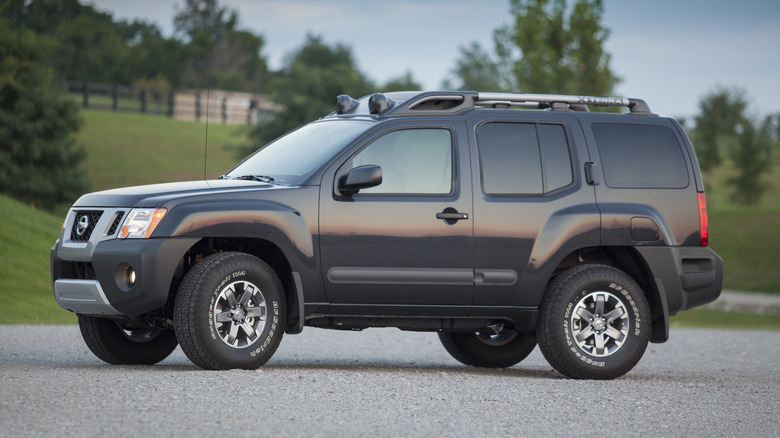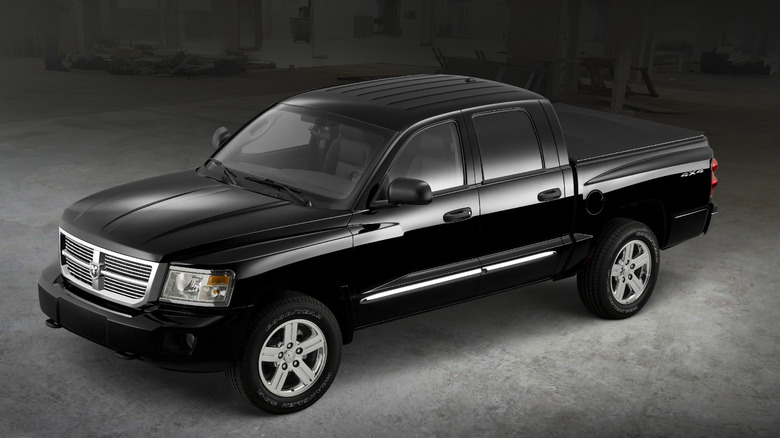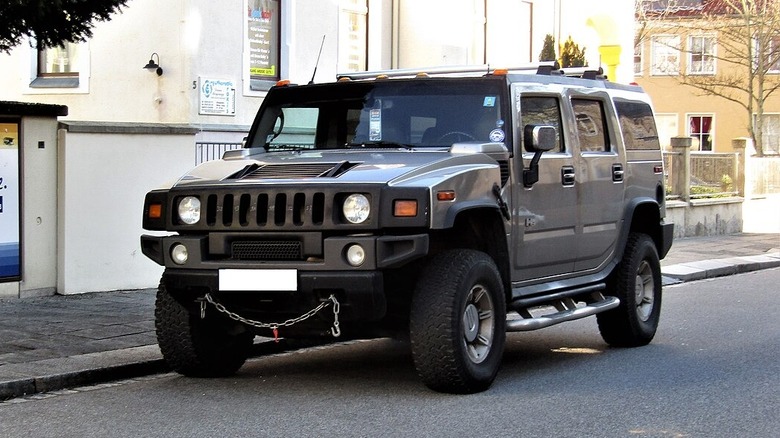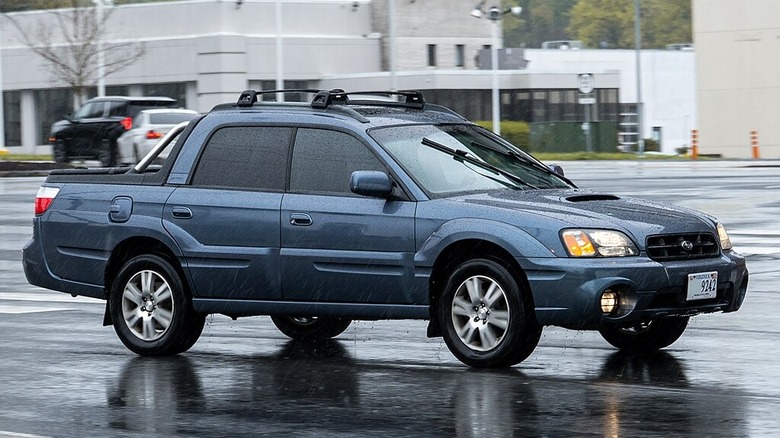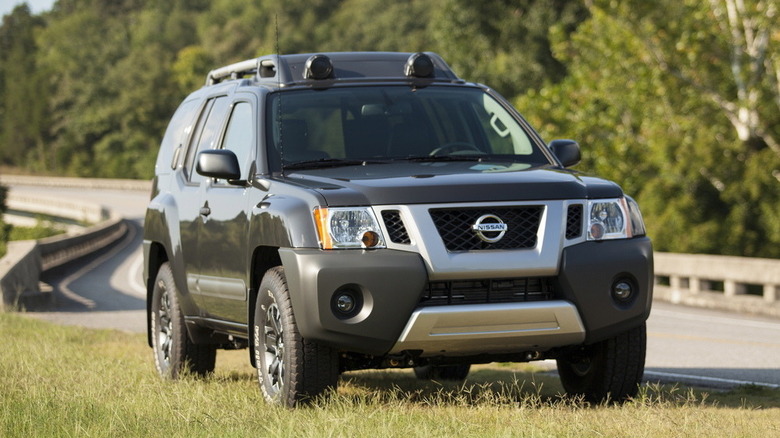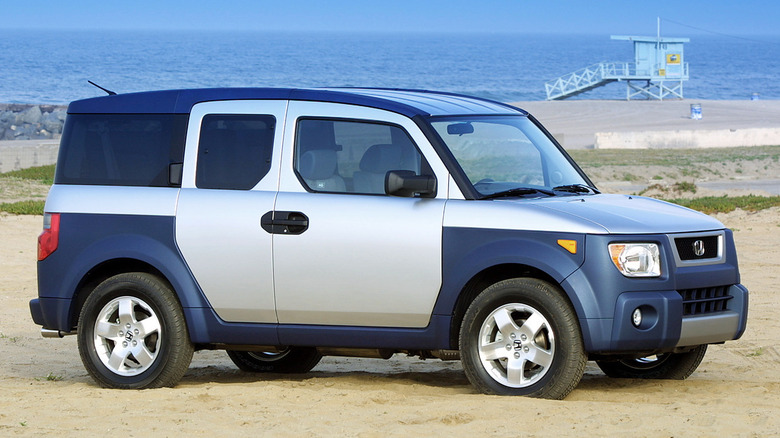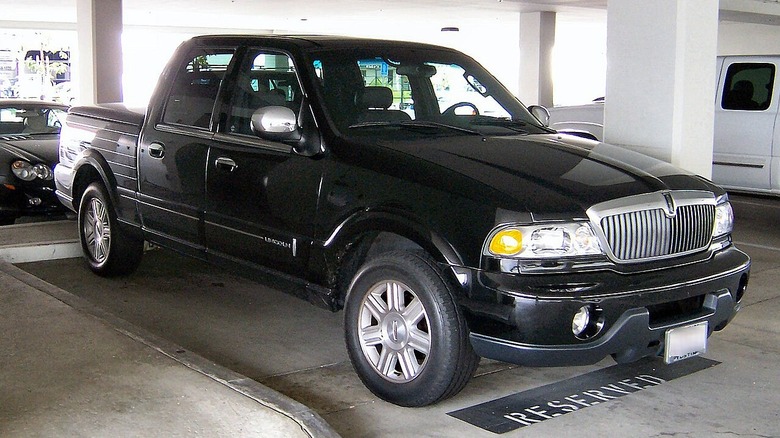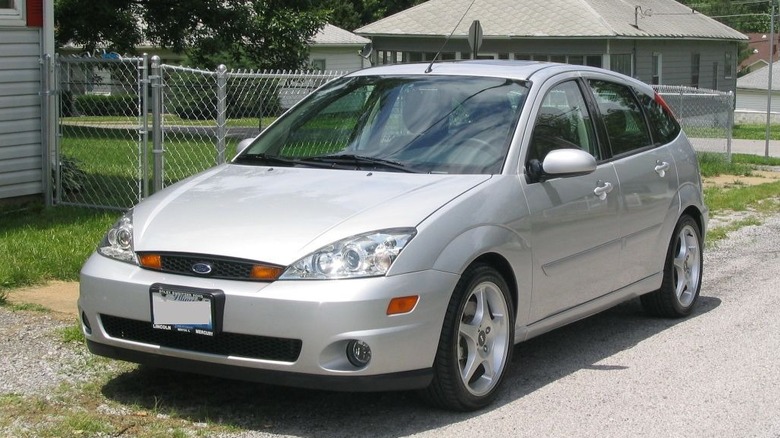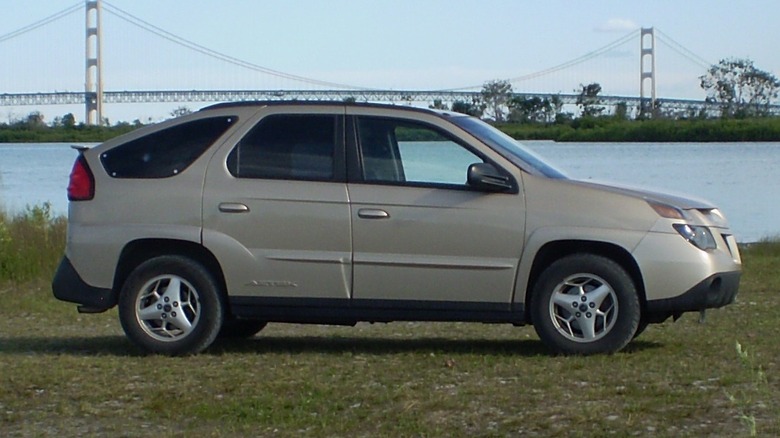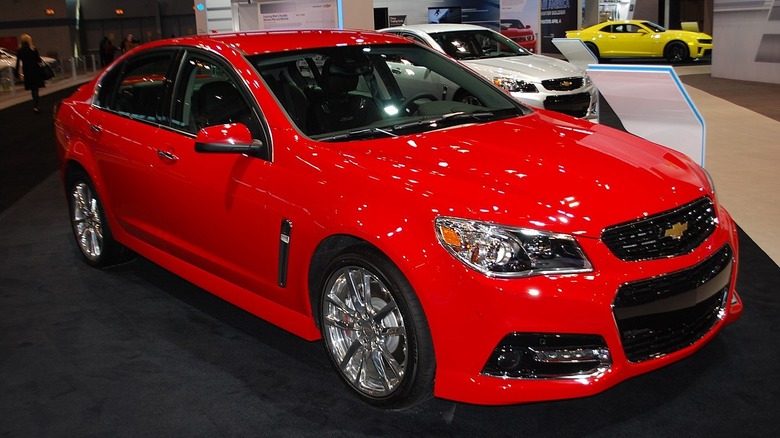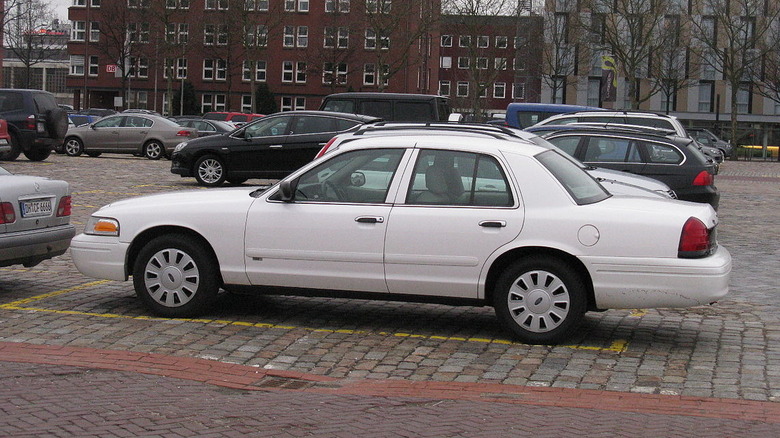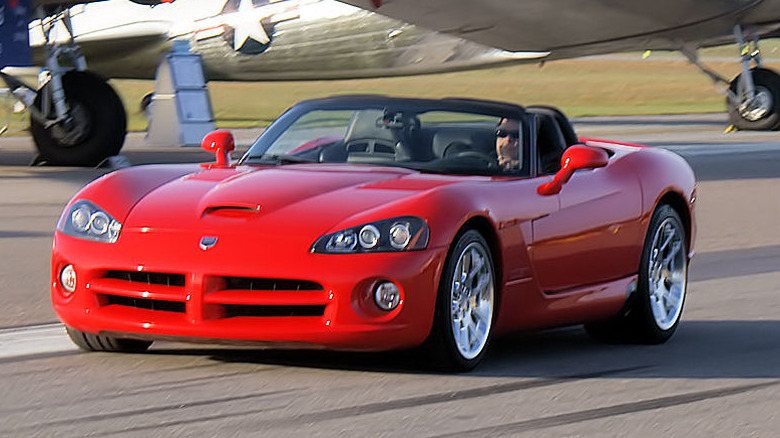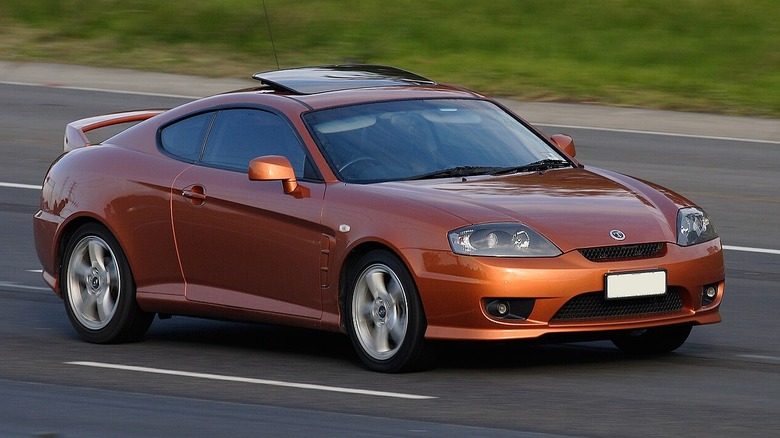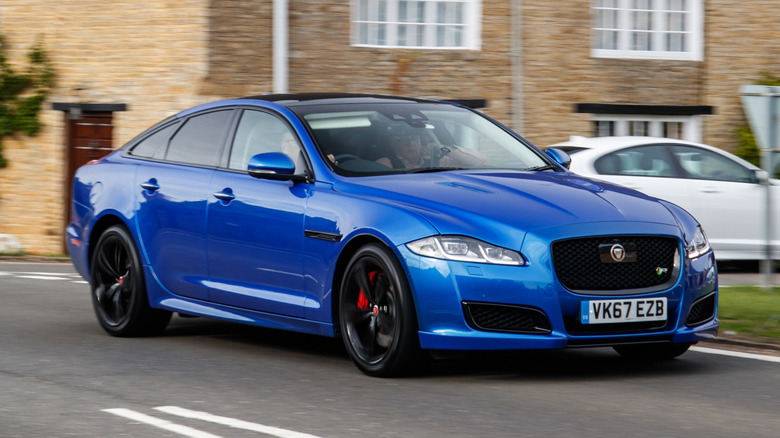13 Discontinued Cars From The 2000s That Would Have Been Popular Today
Looking back at discontinued cars from the 2000s, the many changes and consistencies over the past 25 years are striking. Back then, all-electric cars were few and far between. Looking at you, Ford Ranger EV. But, the landscape for massive gas-guzzling land yachts in the aughts contained such bloated barges as the Hummer H2. Today, Hummer is back with an EV that might be heavy enough to collapse country road bridges, and its parent company continues to sell gas-powered brutes that barely move the needle on fuel consumption versus the H2.
Another common thread is the number of automakers that were too far out in front of the herd with memorable models like the Subaru Baja and Pontiac Aztek lampooned for weirdness, but ready to dominate the aspirational adventure lifestyle so craved by 2025 consumers. Back in the day, you would have been ridiculed to suggest Ford Motor Company would stop making cars, but here we are. There were a whole lot of discontinued cars from the 2000s that, for a variety of reasons, would be popular in the present day. These 13 are the models we think have the best chance at success.
Dodge Dakota
In the 2000s, you could buy a Dodge Ram 1500. Today, you can buy a Ram 1500 as Stellantis has seen fit to split Dodge into a purveyor of cars and crossovers, while Ram does trucks. Marketing nonsense aside, the smallest truck you'll find at Ram is the 1500. Meanwhile, the midsize segment is bursting with competition from the Ford Ranger and Chevy Colorado to the Toyota Tacoma and Nissan Frontier. Why doesn't Ram sell one? That's a longer story, but the company used to offer the Dodge Dakota midsize pickup.
It was in production until 2011 and at the time, offered a choice of V6 or V8 power, up to 7,200 pounds of towing capacity, and an extended or crew cab body. Dakota crew cabs were within a few inches of the 2025 Chevy Colorado and that model can only tow 500 more pounds than the Dodge once did. We know that Dodge is planning to bring a midsize pickup back to the U.S. market, but details are scant. Based on how broad this segment has become, it's easy to imagine Ram fans going into a frenzy over a new Dakota. So hey Ram, chop chop.
Hummer H2
The Hummer H2 was evidently such a pig at the pumps that the U.S. EPA deigns it unworthy of listing on the FuelEconomy.gov site. Per J.D. Power, however, the H2's fuel "efficiency" is about 10 mpg city, 13 mpg highway, and 11 to 12 mpg combined. The H2 was produced until 2010. Jump ahead 15 years and GMC, current owner of the Hummer brand, sells its Yukon with a powertrain capable of 14 mpg, 18 mpg, and 16 mpg, respectively. To hit those numbers, you must choose the 6.2L V8, an engine also found in the H2.
Back then, it made 393 horsepower and 415 lb-ft of torque. Today, those figures come in at 420 and 460, respectively. The Yukon can tow 8,400 pounds versus the H2's 8,200. Yes, the formerly discontinued Hummer brand is back from the dead, but its only option is a comically huge EV. Considering GMC basically sells an old H2 rebadged as a Yukon, why not go full circle and badge-engineer the 2025 Yukon into a 2025 Hummer H2? It would fill out the modern-day Hummer portfolio and offer additional chum for America's endless feeding frenzy of huge SUVs.
Subaru Baja
As evidence the quirky Subaru Baja would be popular today, I direct your attention to the Hyundai Santa Cruz. Like the Baja, the Santa Cruz tacks a roughly 4-foot pickup truck-style cargo bed onto the back of a unibody crossover platform. Both feature fully independent suspension, a choice of naturally aspirated or turbocharged four-cylinder engines, and just about 8.5 inches of ground clearance. The Outback-based Baja came standard with AWD and could tow 2,400 pounds. The Santa Cruz offers AWD and can tow more than the Subaru at 3,500 pounds, but we're still talking about small watercraft and teardrop trailers here.
Considering the Santa Cruz is only 3 inches longer than the Baja, it would appear Hyundai benchmarked Subaru when creating its own light-duty pickup truck. The Subaru Baja was discontinued after a short run from 2003 to 2006, but it was arguably ahead of its time with cool features like the Switchback cabin-to-bed divider that could be opened for long cargo and the wide range of accessories aimed at outdoorsy clientele. Swap the 2025 Outback's cargo hold for a pickup bed and the Baja would be back, primed for battle in the red-hot adventure-lifestyle segment.
Nissan Xterra
Nissan is in need of a shot in the off-roading arm and we think the Xterra is one of the best ways to revive the brand. At present, Nissan's ICE-powered SUV lineup consists of the cutesy Kicks, urban runabout Rogue, FWD Pathfinder, luxury-leaning Murano, and Armada land yacht. Toyota offers the 4Runner and Land Cruiser, Jeep has its old Wrangler warhorse, and Ford has the big and bad Bronco. Nissan has dabbled in its former off-road SUV glory with the Pro-4X Armada, but it's unlikely to see more action than a dirty Whole Foods parking lot. However, the Frontier pickup is still on sale.
Which is why the Xterra would be an ideal discontinued car from the 2000s, ready to strut its off-road stuff today. Take the Frontier platform, drop on a closed-bed top hat, and Bob's your uncle. The old Xterra was a serious off-roader. In fact, the Off-Road trimline had better approach and departure angles than the most aggressive current 4Runner and even offered a manual transmission. Plus, the Xterra triathlon race series is still a going concern. One can just imagine the level of consumer froth were Nissan to unveil a reborn off-road-ready Xterra at one of these events. Bring back the stick and it's a homerun.
Honda Element
There are many reasons why the Honda Element was discontinued after eight years in production starting in 2003, but I'd say this box-on-wheels was just too early to the party. Positioned as a utilitarian Swiss Army knife-like crossover, the Element had a urethane-coated floor, clamshell-style side doors, and a tailgate to ease loading of cargo, and the seats could all be folded flat for in-car camping. The "removable skylight" was a panel mounted toward the back of the roof that could be removed for nighttime stargazing, and "Waterproof Fabric for Extreme Conditions" was ready for maximum adventure during the day.
If that wouldn't resonate with the legions of crossovers on sale in 2025 clamoring to be your favorite surf/kayak/mountain bike/ski/BASE jumping ride, nothing would. Back in the 2000s, the Element was thought to be weird for its heavy use of black plastic cladding. But Subaru ensured chunky plastic body parts never left, and even Lamborghini has joined the ranks of automakers slathering their rough-roaders with the stuff. With a 2.3L inline-4 making 166 hp and unibody construction, the old-school Element would be right at home in today's automotive landscape. I'd buy one.
Lincoln Blackwood
Unlike the Honda Element, the Lincoln Blackwood should not be resurrected as a carbon copy of its discontinued self. A regular oddball with striped faux wood trim, a largely cosmetic cargo bed, and Frankenstein-like Navigator front clip on an F-150 body, the Blackwood leaves little mystery as to why Lincoln stopped making pickup trucks. However, over the 23 years since the Blackwood's demise, Ford has done two things that would ensure this discontinued 2000s ride would be popular today.
One, Ford has dramatically improved its badge engineering efforts. The 2025 Aviator stands out on this front as looking very different, and quite handsome, compared to its Ford Explorer donor platform. Two, Ford already sells a $92,985 F-150 as the fully loaded Platinum Plus. It has snooty features like a Smoked Truffle cabin design and massaging front seats. In 2025 dollars, the Blackwood's $52,000 sticker was about $92,000. Coincidence? I think not. Of course, Ford is not the only pickup maker selling incredibly pricey models. See the GMC Sierra Denali Ultimate and Ram 1500 Tungsten for reference. Simply reskin the 2025 F-150 with Lincoln-y lines, apply proper badging, and voila! You have a new Blackwood ready to rock an existing segment.
Ford Focus
Henry Ford surely would have laughed had you told him that one day his eponymous automobile juggernaut would no longer sell cars. But that was then and as of now, Ford sells only the Mustang among its fleet of crossovers and trucks. Regular cars are gone, which is a shame as there was much excellence along the way, including the Focus. Sold between 1998 and 2025, the full story behind what happened to the Focus is interesting, but we're zeroed in on the lineup from the 2000s.
In 2002, you could buy a Focus as a 3-door or 4-door hatchback, a 4-door sedan, or a 5-door wagon. There was even a hotrod SVT variant in the mix. Fuel efficiency was strong at 25 mpg around town, 32 on the highway, and 28 combined for models with a manual thanks to a 2.0L four-cylinder engine rated for between 110 and 130 hp. Today, that blend of attributes has been massaged and improved by the likes of the Hyundai Elantra, Toyota Corolla, and Honda Civic. Sure, station wagons have fallen out of favor, but it's easy to imagine a 2025 Ford Focus lineup competing amongst this robust pool of small car options.
Pontiac Aztek
No list of discontinued cars from the 2000s that would be popular today is complete without the Pontiac Aztek. Autodom's poster child for ugly cars, the Aztek was ahead of its time. Built from 2001 to 2005, it was a pioneer in the crossover movement that is endlessly popular today. Riding on a FWD unibody platform with the option for AWD, the Aztek would fit right in among GM's current crop of similarly engineered crossovers. Reviving Pontiac might be a stretch, but the General still has plenty of brands to choose from for a new Aztek.
Proving its adventure bona fides, the Aztek could tow 3,500 pounds, allow 93 cubic feet of cargo, and the open rear end could be converted into a full-on tent with an inflatable mattress designed specifically for the space. There was even a removable cooler between the front seats! And you thought that roof nest on your Outback was cool. Speaking of the Outback, Time magazine derided the Aztek as "a bulky, plastic-clad mess" that was "deformed and scary." Based on what Subaru has done to its formerly cool station wagon on stilts for 2026, I'd say the Pontiac Aztek would be right at home in 2025. Popular, even.
Chevrolet SS
If we're getting technical, the Chevy SS was from the 2010s, not the 2000s, but 2014 was year one, so close enough. You could also point to the earlier Pontiac G8, another Holden-derived muscle sedan for the U.S. market, as something consumers would clamor for today. But, we've already got a Pontiac that needs to come back, so let's look at this Chevy. It had a 6.2L V8 good for 415 hp and 415 lb-ft of torque. Power was sent to the rear wheels through a limited-slip diff, it rode on staggered-width rubber, and featured 14-inch Brembo brakes up front.
Ultimately, Chevy would grant the SS a manual transmission and it would go on to become enthusiast catnip. That's nice, but surely the idea of a high-horsepower RWD sports sedan would be a sales disaster in today's efficiency-focused automotive environment, right? Considering Dodge is stuffing its twin-turbo Hurricane ICE into the new Charger, a car that was supposedly just an EV, that would seem not to be the case. And with the near certainty that the bro-brand is reviving its Charger with a Hemi V8, I'd say a reborn Chevy SS would be very well received.
Ford Crown Victoria
In its prime, the Ford Crown Victoria was the car of choice for taxi drivers and police departments nationwide. After a 19-year run, Ford discontinued the Crown Vic and since then, the U.S. marketplace has become devoid of domestic full-size sedans. There are plenty of big luxury rigs on sale, like the Lexus LS and BMW 7-Series, but the mainstream lane is empty. Meaning, a Ford Crown Victoria in 2025 would have the segment to itself. A sort of disruptor in an arena once full of choices. Not everyone wants an SUV, and for those folks, the Crown Vic has much to offer.
It seats up to six, offers 40 inches of backseat legroom, and sports a huge 21 cubic-foot trunk. The Lexus LS, by comparison, comes with a 17 cubic-foot trunk or just 12 for the hybrid variant. Ford would likely swap the old V8 for one of its many EcoBoost powertrains, but the Crown Vic's durable body-on-frame construction was one reason for its long-time success. Ford is effectively out of the car business, so a 2025 Crown Victoria would be a compelling return to form for the Blue Oval, likely to draw huge interest from police departments and private citizens alike.
Dodge Viper
Dodge currently sells just three vehicles, not exactly the kind of lineup that screams, "My parent company is showering me with investment dollars!" It could use some help, and a car the automaker once described as an "8.3-liter can of whoop ass" would seem up to the task. That car is the Dodge Viper, a former icon of the sports car industry built between 1992 and 2017. For our look at discontinued cars from the 2000s that would be popular today, however, we're focused on the ZB1 series that ran from 2003 to 2006.
It had the aforementioned V10 lump up front churning out 500 hp and 525 lb-ft of twist. The 19" rear wheels were mounted in 13.5" wide rubber. It could go from 0-60 in less than 4 seconds, reach 190 mph at the top end, pull 1.0 g on the skidpad, and possibly fry some eggs on the side pipes afterward. Nobody is selling a V10-powered car anymore, but Chevy is still selling the Corvette. It has exactly zero domestic competition, and if the bonkers ZR1 is any indication, there is an appetite for hugely powerful sports cars made in America. Dodge, the Viper needs to return.
Hyundai Tiburon
Before Genesis was a standalone brand, there was the sharp-dressed Hyundai Genesis Coupe. And before that, there was the Tiburon. Not the gawky first-gen Tiburon, but the sleeker second-gen model. It came with a 2.0L inline-4 or a 2.7L V6 making 172 horsepower and 181 lb-ft of torque. Transmission options included a 5- or 6-speed manual; it weighed just about 3,000 pounds depending on configuration, and cost between $15,000 and $20,000 when new, circa 2003. Not a rocket and not even a "proper" sports car given its FWD layout, the Tiburon would nonetheless be a popular counterpoint to the Toyobaru twins and Mazda Miata that currently make up the affordable sports car market.
The Toyota GR86 is more powerful, but it has a similar curb weight to the old Tiburon and today would boast Hyundai's 10-year powertrain warranty, 3 years of complimentary maintenance, and value-packed pricing model. Sporty coupes are out of favor for sure, but Toyota, Subaru, and Mazda continue to innovate in the space. There's no reason Hyundai couldn't be right in there, too.
Jaguar XJ
For 41 years, starting in 1968, Jaguar built its XJ flagship sedan as a series of iterative design updates. Never straying far from the original look, the XJ became staid you might say. That changed in 2009 when the British automaker unleashed a dramatically overhauled XJ with slim headlights, a coupe-like profile with a "floating roof" D-pillar, and striking taillights. The 5.0L V8 powertrain came in two flavors — naturally aspirated with 385 horses or a supercharged, 510-horsepower beast. Inside, these Jags were nothing short of opulent, with features like hand-polished mirror-matched oak veneer with linear laser inlays, truffle and cashew-themed leathers, 20-way massaging thrones, and climatized rear seats.
This overt expression of excess would be a huge hit among today's range of luxury liners like the Mercedes S-Class and Audi A8. Depending on the approach, the Jaguar XJ could even go up against Bentley. In either case, this final XJ would be a breath of fresh air among the largely tame full-size luxury sedan designs on sale today (Genesis G90 excepted). With Jaguar looking to be on the verge of a long catnap, its excellent final XJ could be just the thing to bring the brand back to form.
